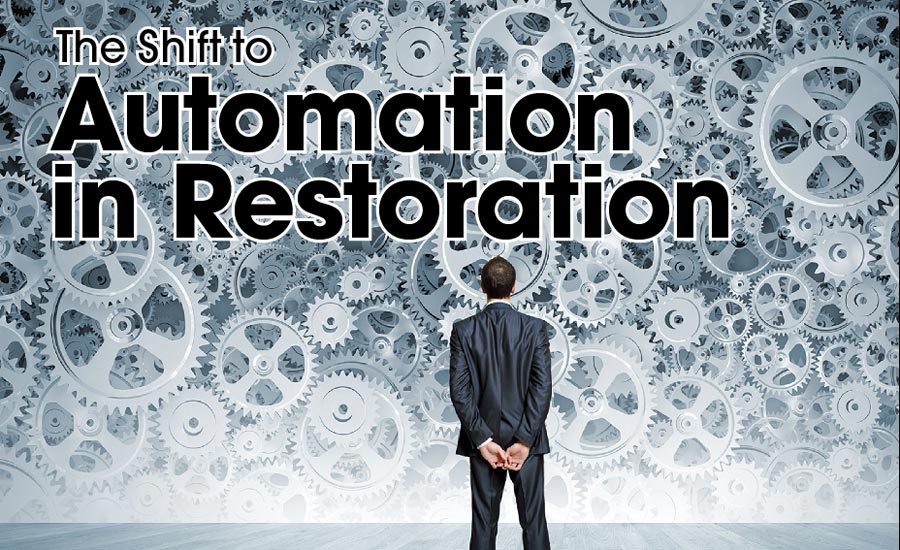The Shift to Automation in Cleaning
Article written by Ryan Pritchard
From day one, contractors used pen and paper to capture everything into manila folders; the rest kept in memory and traveled through word of mouth. This hindered their ability to locate information and react to critical issues quickly. The loss in productivity and increased cycle times limited a company’s capacity to handle incoming jobs. As the needs and expectations of the customer started to advance, there became a desire for more sophisticated systems. Software tools were designed to better manage and spread information quickly. A fundamental flaw of these tools was that they required constant data input to provide any meaningful information – garbage in, garbage out. The industry was populated with people who were resistant to the use of technology. The paper thrived and over the last three decades, trends show our consumption of paper has tripled. Even today, 90 percent of all information recorded in business captured on or printed to paper.
There are few opportunities where technology has been used to standardize information across the board. In the restoration space, Xactware became the standard for estimating. In 1995, they released a data collection tool called Xactanalysis, which acted as a communication bridge between contractors and carriers. From its inception, it took almost six years for the industry to embrace and by 2001, there was enough data to start benchmarking industry averages. On average, it took 11 days from a claim received before the customer was contacted; 13 days from the customer contacted to inspected, and 33 days after the inspection before an estimate written and returned. These numbers greatly inflated when introduced to a catastrophic loss. The numbers collected were based on submitted job files across North America and numbers don’t lie. To achieve higher efficiency and response times, contractors faced with limited choices: increase staff and administration or do away with paper folders and embrace the automation in technology.
In the early 2000s, the industry exploded with a plethora of different software solutions, each one managing different aspects of business like claims intake, file management, moisture tracking, content inventory, job costing, mobile field apps, CRM, and more. Each provided a better way to increase the contractor’s visibility and see information in real-time. However, the need to provide timely updates and communications to customers required these systems to stay connected 24/7. Smart devices became the tool of choice, opening the door for contractors to mobilize their workforce from anywhere, anytime.
Those who leveraged these technologies became efficient at coordinating and responding to the rapidly changing industry. The speed of information was steadily increasing along with expectations to record more and respond quicker. In hopes to automate production, these standalone technologies added another layer of complexity. Additional data entry required to feed separate systems, creating duplication and adding extra costs. Statistically, one out of every 100 keystrokes an error, which multiplied by the number of times information duplicated. The need for office administrators to manage data, its integrity, and ensure things were not missed became an everyday burden. The industry demanded more connectivity to pass information seamlessly and reduce the administration.
Information and technology had become an integral part of every restoration business. “Integration” was the new buzz word and in an effort to streamline workflow, companies began offering integrated solutions through API’s or third party connections to bridge the gap. These technologies allowed cycle times to drop significantly and by 2016, statistics showed that average cycle time had dropped to one to two days from a claim received to customer contacted, three days from initial contact to inspection, and six days from inspection to estimate written and returned. The industry began to redefine what required, with expectations becoming more stringent. Compliance was now the focal point for contractors and the ability to measure these a necessity.
However, simply meeting compliance will not ensure success or profitability for your business. Although we embraced the consistent flow of work, it required the right technologies to stay on top and maintain performance.
Industry guidelines now more clearly defined than ever before. Systems built specifically around automating entries to meet and exceed these criteria. However, as technology catches up and allows the contractors to push what is possible.
The industry will adjust again to accommodate new regulations and expectations. Simply meeting these compliances will not ensure your business is successful, profitable, and competitive. There is no doubt technology has come a long way since the beginning and it will continue to evolve, changing the way we do business. As the industry shifts towards automation in production, compliance, and communication, technology will continue to become more critical. Contractors must continue to embrace technology rather than place all of their efforts on just meeting compliance. Work will come from compliance, profitability will come from technology.

